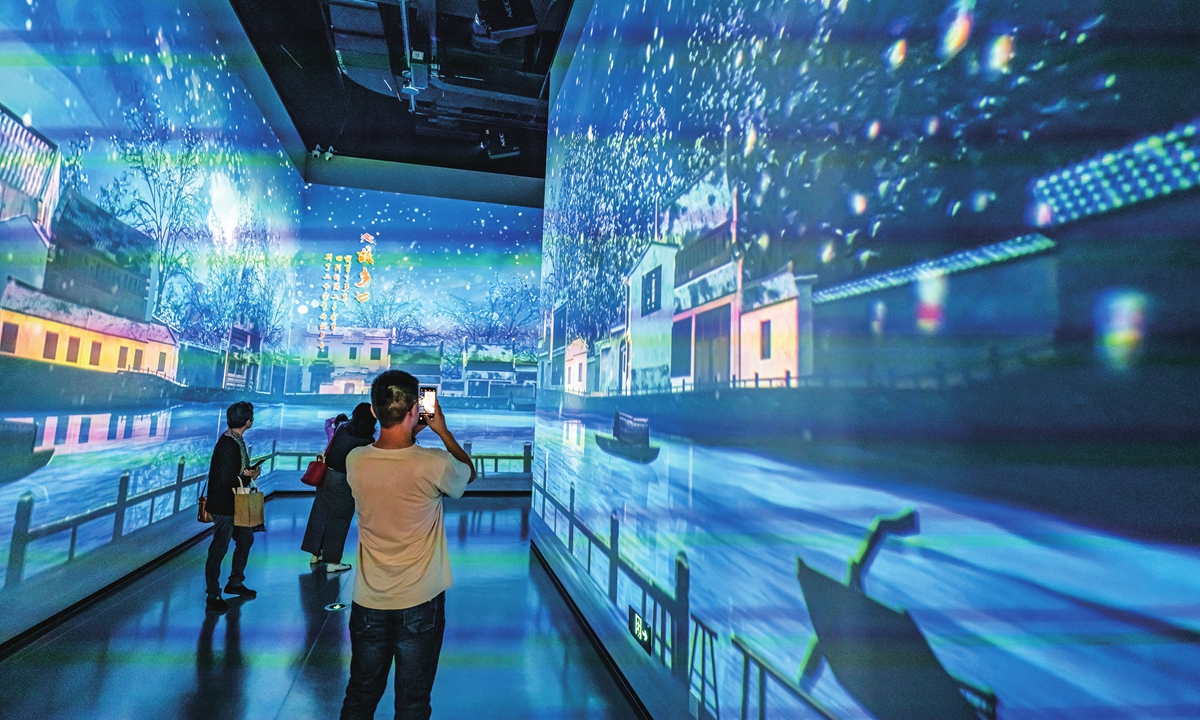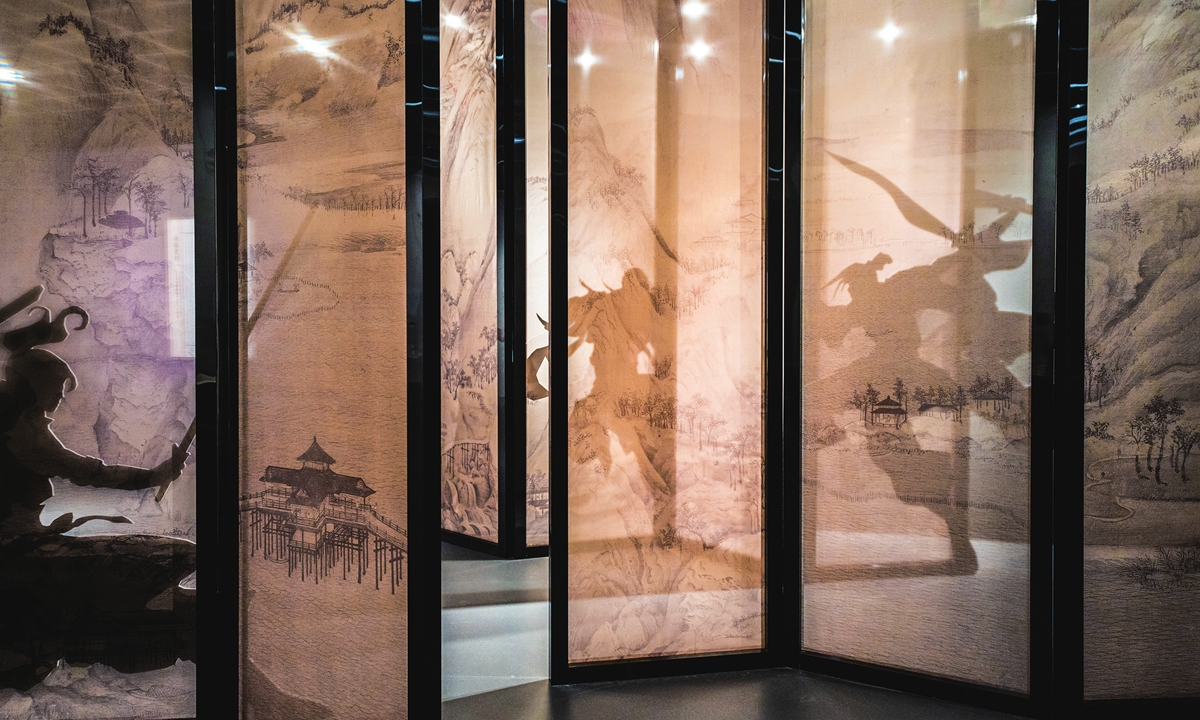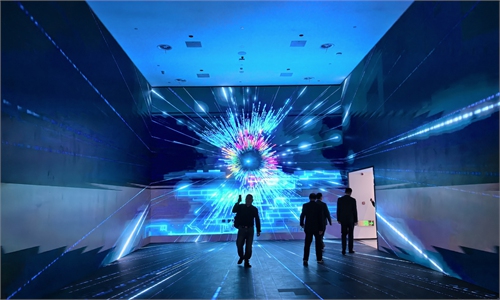ARTS / BOOKS
Zhejiang Literary Center embraces high-tech transformation
An artistic feast

Inside Zhejiang Literary Center Photo: VCG

The Jin Yong Special Exhibition held by Zhejiang Literary Center Photo: Courtesy of Haining Media Center
There is a saying that a history of Zhejiang's literature is half a history of Chinese literature.
In Beijing's National Museum of Modern Chinese Literature (NMMCL), the permanent exhibition about the contemporary Chinese literature is dominated by writers and works from East China's Zhejiang Province.
Now Zhejiang has its own venue to showcase its profuse literary resources.
On September 25, 2023, two important events in the history of Chinese literature were celebrated: the birthday of Lu Xun, a 20th century literary giant from Shaoxing, Zhejiang, and the establishment of Zhejiang Literary Center (ZLC) in Hangzhou. It was the 142nd anniversary of Lu Xun's birthday.
Opening to the public in late October, ZLC is the second largest literature museum in China with a total of nine exhibition halls, only surpassed by the capital's NMMCL.
As a new landmark of Zhejiang, the museum is the brainchild of generations of people in Zhejiang's literary sector as it carries the responsibility of cultural inheritance and promotion of Zhejiang literature, whose writers takes up over 60 percent of the exhibitions at the NMMCL.
More importantly, the museum is designed to meet the public's needs for literature. Its big data platform and use of digital technologies brought classic literature scenes to life and added new dimensions to literature appreciation.
Cheng Shiqing, curator of ZLC, told the Global Times that the museum is committed to creating a year-round literature-sharing platform that caters to individuals of all ages.
"We will try to host themed lectures every week and curate featured exhibitions every quarter of the year to foster a love for literature among the public, and deepen their understanding and appreciation of the literary world," said Cheng.
On the one hand, the museum will bring together excellent literary resources from home and abroad. On the other hand, it will promote more outstanding Zhejiang writers to the national and international stage. These are the two missions of the museum.
In a bid to bring the development of literature to a new height, the museum is on course to build three research centers, one dedicated to Chinese literature big data, one to contemporary children's literature research, and one to China's international collaborative translation.
"The translation center is dedicated to promoting exchanges with foreign writers and we welcome foreign counterparts to Hangzhou to experience the rich history of Chinese literature," Cheng said.
Three-dimensional exhibits
In addition to the conventional way of displaying exhibits, one of the highlights of the museum is to present classic scenes of literary works by means of digital technology, giving readers an immersive experience into the process of creation.
Having refined 129 photos from Lu Xun's life, the modern literature hall of the museum pulled together a dynamic view of the literary giant's journey in writing.
A towering 14-meter-high space is meticulously designed to connect the four distinct landscapes of Zhejiang with their corresponding poems and poets. This provides visitors with a poetic perspective of how the region's breathtaking natural beauty inspired a series of classic rhymes.
Paintings in the Song Dynasty (960-1279) were used as symbols to show the boldness and gracefulness of the poems written in that period.
Scenes from some classic works such as Lu Xun's Hometown, Mao Dun's Spring Silkworms, and Dai Wangshu's Alley in the Rain, were reproduced and presented at the museum.
"Leveraging the massive amount of data, we have applied digital technology in presenting a Chinese literary geography and various informational graphs. The smart devices added a new dimension to the conventional exhibits," said Cheng.
"Taking a big step in the application of digital innovations, we are trailblazers in digitizing Chinese literature. We hope to set an example for the industry," the curator said.
Interactive space
Since its official opening on October 28, the museum has received about 3,000 daily reservations, and some well-designed events and exhibitions have drawn floods of visitors on weekends.
One of the most popular exhibitions pays tribute to Louis Cha (Cha Leung-yung), also known as Jin Yong, another literary legend from Zhejiang.
The show is dedicated to commemorating Jin's 100th birthday in 2024. Born in Haining in 1924, Jin was regarded as one of the greatest and most popular martial arts writers.
Xu Jing, an official with ZLC's publicity department, told the Global Times that the exhibition sheds light on Jin's life and works, and it's also the first time that some manuscripts of the writer has been presented to the public.
Swords, bows and arrows, which are featured in Jin's novel, were replicated and installed in the hall to give visitors an interactive experience of Jin's "martial arts world," and a digital reading space was set up to allow people to read or listen to his novels.
Various versions of Jin's novels are on display, including the earliest versions originally serialized in newspapers, which were widely circulated in the Chinese mainland, as well as abroad through versions in English, French and Japanese.
Younger readers have been captivated by a space dedicated to children's literature.
"We wish to make the children's literature space into a parenting space, where adults and children can interact and develop a love for reading and writing. It will also evoke adult readers' childhood memories," said Cheng.
"We want to have relics find their home in our museum. Most importantly, we want literature lovers to find their home in the museum," Cheng said.

